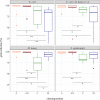A view to a kill? - Ambient bacterial load of frames and lenses of spectacles and evaluation of different cleaning methods
- PMID: 30485312
- PMCID: PMC6261565
- DOI: 10.1371/journal.pone.0207238
A view to a kill? - Ambient bacterial load of frames and lenses of spectacles and evaluation of different cleaning methods
Abstract
Surfaces with regular contact with the human body are typically contaminated with microorganisms and might be considered as fomites. Despite spectacles being widespread across populations, little is known about their microbial contamination. Therefore, we swab-sampled 11 worn spectacles within a university setting as well as 10 worn spectacles in a nursing home setting. The microbial load was determined by aerobic cultivation. All spectacles were found to be contaminated with bacteria, with nose pads and ear clips having the highest density, i.e. at sites with direct skin contact. Summed over all sites, the median microbial load of the university spectacles (1.4 ± 10.7 x 10(3) CFU cm-2) did not differ significantly from the spectacles tested in the nursing home (20.8 ± 39.9 x 10(3) CFU cm-2). 215 dominant bacterial morphotypes were analyzed by MALDI biotyping. 182 isolates could be assigned to 10 genera, with Staphylococcus being the most common. On genus-level, bacterial diversity was greater on nursing home spectacles (10 genera) compared to the university environment (2 genera). Four cleaning methods were investigated using lenses artificially contaminated with Escherichia coli, Micrococcus luteus, a 1:2 mixture of E. coli and M. luteus, and Staphylococcus epidermidis (the dominant isolate in our study), respectively. Best cleaning results (99% -100% median germ reduction) were obtained using impregnated wipes; dry cleaning was less effective (85% -90% median germ reduction). Finally, 10 additional worn university spectacles were cleaned with wipes impregnated with an alcohol-free cleaning solution before sampling. The average bacterial load was significantly lower (0.09 ± 0.49 x 10(3) CFU cm-2) compared to the uncleaned university spectacles previously investigated. Spectacles are significantly contaminated with bacteria of mostly human skin origin-including significant amounts of potentially pathogenic ones and may contribute to eye infections as well as fomites in clinical environments.
Conflict of interest statement
The affiliation of some authors with Carl Zeiss Vision International GmbH does not alter the adherence to PLOS ONE policies on sharing data and materials.
Figures



Similar articles
-
Eye-Catching Microbes-Polyphasic Analysis of the Microbiota on Microscope Oculars Verifies Their Role as Fomites.J Clin Med. 2020 May 22;9(5):1572. doi: 10.3390/jcm9051572. J Clin Med. 2020. PMID: 32455878 Free PMC article.
-
Using ATP measurements to rapidly evaluate the cleanliness of spectacle surfaces.BMC Res Notes. 2025 May 14;18(1):216. doi: 10.1186/s13104-025-07282-4. BMC Res Notes. 2025. PMID: 40369647 Free PMC article.
-
Site-specific molecular analysis of the bacteriota on worn spectacles.Sci Rep. 2020 Mar 27;10(1):5577. doi: 10.1038/s41598-020-62186-6. Sci Rep. 2020. PMID: 32221361 Free PMC article.
-
Bacteria on smartphone touchscreens in a German university setting and evaluation of two popular cleaning methods using commercially available cleaning products.Folia Microbiol (Praha). 2015 Mar;60(2):159-64. doi: 10.1007/s12223-014-0350-2. Epub 2014 Oct 11. Folia Microbiol (Praha). 2015. PMID: 25305112
-
Application of quantitative microbial risk assessment for selection of microbial reduction targets for hard surface disinfectants.Am J Infect Control. 2014 Nov;42(11):1165-72. doi: 10.1016/j.ajic.2014.07.024. Epub 2014 Sep 17. Am J Infect Control. 2014. PMID: 25241163
Cited by
-
Eye-Catching Microbes-Polyphasic Analysis of the Microbiota on Microscope Oculars Verifies Their Role as Fomites.J Clin Med. 2020 May 22;9(5):1572. doi: 10.3390/jcm9051572. J Clin Med. 2020. PMID: 32455878 Free PMC article.
-
Using ATP measurements to rapidly evaluate the cleanliness of spectacle surfaces.BMC Res Notes. 2025 May 14;18(1):216. doi: 10.1186/s13104-025-07282-4. BMC Res Notes. 2025. PMID: 40369647 Free PMC article.
-
Comprehensive Compositional Analysis of the Slit Lamp Bacteriota.Front Cell Infect Microbiol. 2021 Nov 17;11:745653. doi: 10.3389/fcimb.2021.745653. eCollection 2021. Front Cell Infect Microbiol. 2021. PMID: 34869057 Free PMC article.
-
Cultivation-Based Quantification and Identification of Bacteria at Two Hygienic Key Sides of Domestic Washing Machines.Microorganisms. 2021 Apr 23;9(5):905. doi: 10.3390/microorganisms9050905. Microorganisms. 2021. PMID: 33922491 Free PMC article.
-
Site-specific molecular analysis of the bacteriota on worn spectacles.Sci Rep. 2020 Mar 27;10(1):5577. doi: 10.1038/s41598-020-62186-6. Sci Rep. 2020. PMID: 32221361 Free PMC article.
References
-
- Grice EA, Segre JA. The skin microbiome. Nat Rev Microbiol. 2011;9:244–53. 10.1038/nrmicro2537 - DOI - PMC - PubMed
-
- Egert M, Simmering R, Riedel CU. The association of the skin microbiota with health, immunity, and disease. Clin Pharmacol Ther 2017;102:62–9. 10.1002/cpt.698 - DOI - PubMed
-
- Brady RR, Fraser SF, Dunlop MG, Paterson-Brown S, Gibb AP. Bacterial contamination of mobile communication devices in the operative environment. J Hosp Infect. 2007;66:397–8. 10.1016/j.jhin.2007.04.015 - DOI - PubMed
-
- Manning ML, Davis J, Sparnon E, Ballard RM. iPads, droids, and bugs: Infection prevention for mobile handheld devices at the point of care. Am J Infect Control. 2013;41:1073–6. 10.1016/j.ajic.2013.03.304 - DOI - PubMed
-
- Egert M, Späth K, Weik K, Kunzelmann H, Horn C, Kohl M, et al. Bacteria on smartphone touchscreens in a German university setting and evaluation of two popular cleaning methods using commercially available cleaning products. Folia Microbiol. 2015;60:159–64. 10.1007/s12223-014-0350-2 - DOI - PubMed
Publication types
MeSH terms
Substances
LinkOut - more resources
Full Text Sources
Other Literature Sources
Medical

